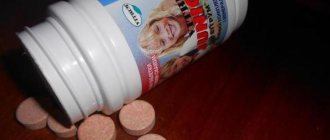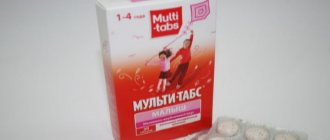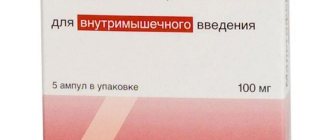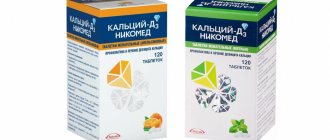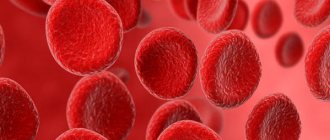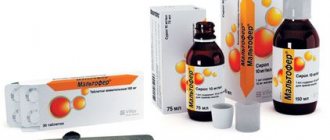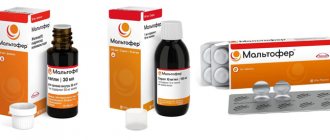Release form and composition
The drug is produced in the form of chewable tablets: flat, round, scored, brown with white inclusions (10 pieces in blisters, in a cardboard pack 1 or 3 blisters and instructions for use of Maltofer Fol).
Composition for 1 chewable tablet:
- active ingredients: iron [in the form of iron (III) polymaltose hydroxide] – 100 mg; folic acid – 0.35 mg;
- auxiliary components: purified talc, cocoa powder, dexrates, vanillin, microcrystalline cellulose, macrogol 6000, sodium cyclamate, chocolate flavor.
Similar drugs:
- Feroplectum Oral tablets
- Ferrum Lek Solution for intramuscular administration
- Sorbifer Durules Tablets
- Ferrous gluconate 300 Oral tablets
- Tot'héma Oral solution
- Likferr 100 (LIKFERR 100) Solution for injection
- Venofer Solution for infusion
- Hemofer Oral drops
- Ferrum Lek Chewable tablets
- Hemofer (Hemofer) Dragee
** The Drug Directory is intended for informational purposes only. For more complete information, please refer to the manufacturer's instructions. Do not self-medicate; Before starting to use the drug Maltofer Fol, you should consult a doctor. EUROLAB is not responsible for the consequences caused by the use of information posted on the portal. Any information on the site does not replace medical advice and cannot serve as a guarantee of the positive effect of the drug.
Are you interested in the drug Maltofer Fol? Do you want to know more detailed information or do you need a doctor's examination? Or do you need an inspection? You can make an appointment with a doctor - the Euro lab is always at your service! The best doctors will examine you, advise you, provide the necessary assistance and make a diagnosis. You can also call a doctor at home . Euro lab clinic is open for you around the clock.
** Attention! The information presented in this medication guide is intended for medical professionals and should not be used as a basis for self-medication. The description of the drug Maltofer Fol is provided for informational purposes and is not intended for prescribing treatment without the participation of a doctor. Patients need to consult a specialist!
If you are interested in any other drugs and medications, their descriptions and instructions for use, information about the composition and form of release, indications for use and side effects, methods of use, prices and reviews of drugs, or you have any other questions and suggestions - write to us, we will definitely try to help you.
Pharmacological properties
Pharmacodynamics
The total average molecular weight of iron(III) hydroxide polymaltosate is about 50 kDa (kilodalton). Its structure is as follows: a polynuclear iron (III) hydroxide molecule is surrounded on the outside by covalently bonded polymaltosate molecules. In its structure, iron (III) hydroxide polymaltosate is similar to the core of the ferritin protein, which is a physiological iron depot.
Under physiological conditions, iron (III) hydroxide polymaltosate is quite stable and releases iron ions in small quantities. Due to its large size, the degree of diffusion of the protein through the mucous membranes is almost 40 times less than that of the complex, which includes hexahydrate iron (II). The iron contained in iron (III) hydroxide polymaltosate is actively absorbed in the intestines.
Folate (folic acid) is one of the B vitamins. Folic acid is a precursor of tetrahydrofolate, which in turn functions as a coenzyme for various metabolic processes, including the biosynthesis of thymidylates and nucleic acid purines. Tetrahydrofolate is necessary to maintain erythropoiesis and nucleoprotein synthesis.
The effectiveness of Maltofer Fol for replenishing iron deficiency and normalizing hemoglobin levels has been confirmed by numerous studies conducted in children and adults with different iron depot status.
Pharmacokinetics
The mechanism of absorption of iron from iron (III) hydroxide polymaltose is controlled. The increase in serum iron concentration after tablet administration does not correlate with total iron absorption measured as incorporation into Hb (hemoglobin). Studies using radiolabeled iron (III) polymaltosate hydroxide have revealed a strong correlation between the inclusion of iron in erythrocytes and its content throughout the body. The most active absorption of iron from the drug is observed in the small and duodenal intestines. With increasing iron doses, the relative absorption of iron from iron(III) polymaltose hydroxide, measured as incorporation into Hb, decreases. There is also a correlation between iron deficiency (specifically serum ferritin concentration) and the relative amount of iron absorbed (i.e., when iron deficiency is severe, relative absorption improves). In anemia, the absorption of iron from iron (III) hydroxide polymaltose in the presence of food increases, in contrast to the absorption of this macronutrient from iron salts.
Folate is absorbed primarily in the digestive tract, particularly in the small intestine and duodenum. After taking 0.35 mg of folic acid, the degree of absorption is about 80%.
After 30–60 minutes, the maximum concentration of folic acid is observed in the blood plasma (about 11 ng/ml). It actively binds to plasma proteins, passes through the blood-brain barrier and placenta, and penetrates into breast milk.
After absorption, iron binds with transferrin and in this form is used to form hemoglobin in the bone marrow or enters the depot, mainly the liver, where it binds to ferritin.
Folate is metabolized in the cells of the liver, small intestine and other organs. After binding to transport proteins, folic acid is distributed throughout all tissues and organs.
Unabsorbed iron is excreted in the feces. Excretion of folic acid occurs through the intestines (with feces) and the kidneys (with urine).
Folates are removed from the body by hemodialysis.
Maltofer Fol: instructions for use (dosage and method)
Maltofer Fol tablets are taken orally during meals or immediately after meals. They can be swallowed whole or chewed. The daily dose is taken once or divided into several doses.
For iron deficiency anemia, the recommended dose of Maltofer Fol (outside of pregnancy) is 1 tablet 1 to 3 times a day. Therapy is continued until normal Hb levels are achieved, usually within 3–5 months. To restore the iron depot in the body after normalization of hemoglobin levels, the intake is continued for several more months, but in a smaller dose (1 tablet per day).
To treat iron deficiency anemia during pregnancy, take 2-3 tablets of Maltofer Fol per day until normal Hb levels are achieved. Then the drug is continued at a dose of 1 tablet per day at least until the end of pregnancy. This is necessary to replenish the iron depot in the body and to meet the increased need for iron during pregnancy.
Can pregnant women take it?
It is difficult to meet a woman who is not aware that during pregnancy it is necessary to compensate for the lack of iron and it is acceptable to take iron supplements. However, many are scared that Maltofer is a synthetic drug, and in vain: it is completely safe at any stage of gestation.
In 1st trimester
The first trimester is the most important and difficult for both the baby and the mother. Mom feels how her body changes under the influence of hormones, her shape becomes more rounded, and her breasts enlarge. Even your gait can change in the first months of pregnancy!
But much more important processes occur inside the body: the fertilized egg took its rightful place in the uterine endometrium and began to develop, turning into a fetus. In the early stages, the formation of almost all the main organs of the baby occurs, so it is very important not to interfere with this process in any way that could harm the embryo.
Taking Maltofer is not a threatening factor for the development of the fetus. Despite the instructions about the lack of studies conducted in the 1st trimester in the instructions for the drug, many doctors safely prescribe it to women in labor from the first weeks, and this is completely justified. Iron deficiency at the beginning of pregnancy is very dangerous for both the baby and the mother.
In the 2nd trimester
The second trimester gives the expectant mother the least amount of trouble . The child continues to grow and develop, toxicosis is behind him, and the protruding belly does not yet interfere with normal movement. And the baby is very comfortable during this period, because he has already acquired all the organ systems and has acquired good protection in the form of the placenta.
But both organisms still need iron, so Maltofer can come to the rescue at this time. The drug will not harm either mother or baby.
In the later stages
On an ultrasound, the mother can finally, without effort, see the baby’s arms, legs, and head: he is almost formed, and he just needs to reach the right size to be born. At this time, Maltofer can be prescribed, but often there is no longer a need for iron, unless we are talking about anemia.
If the doctor believes that a woman should continue to replenish iron deficiency, the choice may fall on Maltofer , and it is completely justified. The drug does not affect the course of pregnancy in any way and cannot cause complicated childbirth.
Overdose
Iron (III) hydroxide polymaltosate has low toxicity, and the uptake of iron from the drug is controlled, so even with a severe overdose, intoxication or iron overload is unlikely. No cases of fatal poisoning have been recorded.
There is evidence that large doses of folate may cause nausea, flatulence, bloating, and nervous system problems (including hyperactivity, irritability, mental status changes, insomnia, or drowsiness).
Treatment is symptomatic. Folic acid is removed by hemodialysis.
special instructions
One chewable tablet contains 0.04 bread units. In patients with diabetes, taking Maltofer Fol supposedly does not affect the daily need for insulin.
Folic acid may mask vitamin B12 deficiency.
Sometimes the cause of iron deficiency anemia is malignant tumors or infectious diseases. Taking iron supplements can only be started after the underlying cause of the disease has been eliminated, so if immediate therapy is necessary, the ratio of expected benefits to possible risks should be established.
A characteristic sign of taking iron-containing drugs is the discoloration of stool in a dark color, but this fact has no clinical significance.
Impact on the ability to drive vehicles and complex mechanisms
No information provided (but such impact is unlikely).
Analogs
Currently, pharmacies offer a large number of iron preparations . Of those that are allowed during pregnancy, the following can be noted:
- Ferumbo.
- Globiron-N.
- Aquaferrol.
- Actiferrin.
- Hemojet.
- Sorbifer.
- Biofer.
- Ferroplex.
- Durulex.
- Ferrum Lek.
Any of these medications can only be taken as prescribed by a doctor.
Which is better - Maltofer or Sorbifer? The drug Sorbifer deserves special attention. It is distinguished by the content of ascorbic acid, which, according to some data, improves the absorption of iron. If a woman has no contraindications, she can opt for Sorbifer , although both products effectively and quickly compensate for the deficiency of this microelement.
Use during pregnancy and lactation
Maltofer Fol tablets can be used during pregnancy to treat anemia. Studies have shown that the drug poses no danger to either the fetus or the mother.
A woman's breast milk contains iron bound to lactoferrin. There are no data available on the amount of iron obtained from iron(III) hydroxide polymaltose in breast milk. However, the likelihood of any unwanted effects occurring in infants whose mothers take Maltofer Fol is very low.
Before using the drug, pregnant and lactating women, as well as women of childbearing age, are advised to consult a doctor.
Contraindications
Maltofer should not be taken for certain ailments:
- Hemochromatosis.
- Thalasemia.
- Intestinal obstruction.
- Anemia not associated with iron deficiency.
- Frequent blood transfusions or recent blood transfusion.
Also, the drug is not prescribed in case of individual intolerance to its components or in combination with other iron preparations. The tablet form of Maltofer is not recommended for women prone to allergies, as it contains cocoa powder.
Drug interactions
Studies have not revealed clinically significant drug interactions when using iron (III) hydroxide polymaltosate simultaneously with tetracycline, acetylsalicylic acid, calcium carbonate, aluminum hydroxide, sulfasalazine, bromazepam, paracetamol, magnesium aspartate, methyldopa, auranofin, calcium phosphate and calcium acetate in combination with vitamin D3. Also, no interactions were noted with oxalic acid, phytic acid, vitamins A, E and D3, tannin, choline and choline salts, sodium alginate, soy flour and soy oil.
The combined use of oral and parenteral iron-containing drugs should be avoided, since the absorption of iron taken orally is slowed down in this case.
Folic acid may accelerate the metabolism of phenytoin and lead to a decrease in its serum concentration, especially in patients with folate deficiency. Although this interaction is not clinically significant, the frequency of seizures is increased in some patients. Before starting to take Maltofer Fol, patients receiving anticonvulsants should consult with their doctor.
When folic acid and chloramphenicol are used together in patients with folate deficiency, due to the antagonistic effect of chloramphenicol, the hematopoietic response to folic acid may be weakened. The exact mechanism of this interaction and its clinical significance have not been established; however, in individuals receiving these drugs concomitantly, the hematological response to folic acid therapy should be monitored.
Taking the tablets does not affect the selective determination of hemoglobin (occult blood test), so there is no need to interrupt treatment.
Reviews of Maltofer Fall
In general, reviews of Maltofer Fall are positive. The drug helps increase hemoglobin, acting quite quickly. The tablets are easy to take and have a pleasant chocolate taste. The drug can be combined with food and consumed at any time of the day. The medicine is approved for pregnant and lactating women.
Among the disadvantages, the most frequently mentioned are possible side effects (mainly constipation, flatulence and diarrhea), as well as the cost of Maltofer Fol. Anecdotal reports indicate that the pills have been ineffective.
